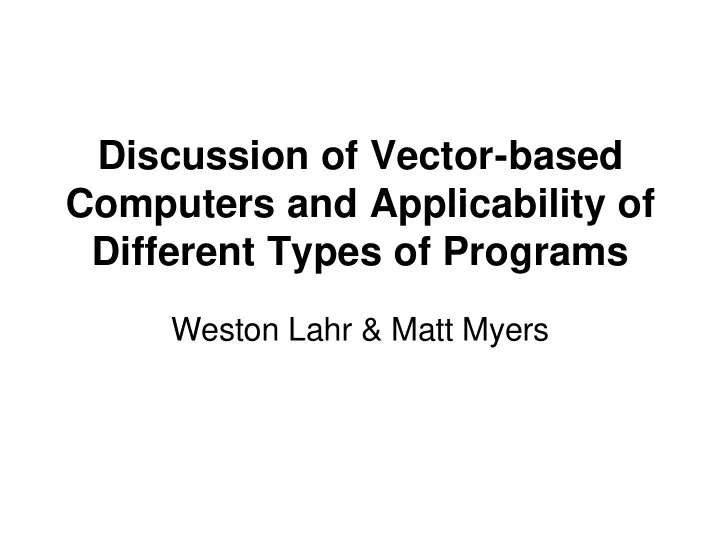

Discussion of Vector-based Computers and Applicability of Different Types of Programs Weston Lahr & Matt Myers
Agenda • Vector Processor vs Super Scalar • Scientific Programs • Evaluation Metrics • Results & Analysis • Closing Comments
Super Scalar • MIMD • Often COTS • Memory Hierarchy – Memory cache – Internode shared memory or communications link • More General Purpose • Power3 & Power4 discussed in paper
Vector Processor • SIMD • More specialized processors • Vector registers • Flat memory (no cache) • Higher cost than multiple RISC • NEC SX-6 discussed in paper – Used in Earth Simulator
Scientific Programs • PARATEC • Cactus • GTC
PARATEC • Uses Density Functional Theory (DFT) to find electron wave functions • DFT used for many problems – Nanostructures – Semiconductors • Written in Fortran90 – Uses MPI
Cactus • Used in astrophysics to find numerical solutions to GR • Simulates astrophysical phenomena – Ex black hold evolution • Uses MPI
GTC • Used in research in magnetic fusion • Solves equations dealing with turbulence in fusion experiments • Uses MPI
Evaluation Metrics • Gigaflops • Gigaflops/Processor • Vector Operation Ratio (VOR) – Optimal – 100% • Average Vector Length (AVL) – Optimal (ES) – 256
PARATEC • Test Case – 432 silicon atom bulk systems • ES – 2.6 TFlops for 1024 processors – 2.08 GFlops/processor – Small test cases prevented valid VOR or AVL – Poor scaling due to smaller AVL • Power3 – .413 Gflops/P for 512 processors • Power4 – 1.08 Gflops/P with 256 processors • Power3 & Power4 scale poorly too because of communications requirements
Cactus • Test Case – 256x64x64 Grid • ES – 2.70 Gflops/P for 1024 processors – 2.7 Tflop/s – VOR of 99% – AVL of 248 (256 optimal) • Power3 – 0.60 Gflops/P with 1024 processors. • Power4 – 0.556 Gflops/P with 16 processors – Results for more processors on the Power4 were unavailable due to a lack of high-memory nodes. • Problem size made a big difference with ES because of lower AVL
GTC • Test Case – 4 million particles and 1,187,392 grid points over 200 time steps • ES – 0.701 Gflops/P – VOR of 98% – AVL of 186 • Power3 – 153 Mflops/s • Power4 – 277 Mflops/s • Power3 & Power4 exhibit superlinear scaling probably due to cache hits • SX-6 did not scale as well
Closing Comments • Vector based computers not as general purpose as super scalars • Very effective for particular types of problems • Not going away anytime soon
Works Cited • Oliker, Leonid et al. “Scientific Computations on Modern Parallel Vector Systems.” SC2004 • Oliker, Leonid, Carter, Jonathan, Shalf, John, Skinner, David, Ethier, Stephane, Biswas, Rupak, Djomeri, Jahed, Van der Wijngaart, Rob et al. “Evaluation of Cache-based Superscalar and Cacheless Vector Architectures for Scientific Computations.” SC2003
Questions?
Recommend
More recommend